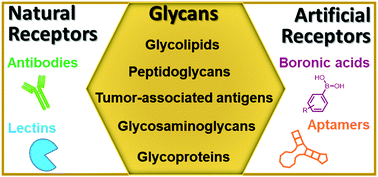The challenges of glycan recognition with natural and artificial receptors
Abstract
Glycans – simple or complex carbohydrates – play key roles as recognition determinants and modulators of numerous physiological and pathological processes. Thus, many biotechnological, diagnostic and therapeutic opportunities abound for molecular recognition entities that can bind glycans with high selectivity and affinity. This review begins with an overview of the current biologically and synthetically derived glycan-binding scaffolds that include antibodies, lectins, aptamers and boronic acid-based entities. It is followed by a more detailed discussion on various aspects of their generation, structure and recognition properties. It serves as the basis for highlighting recent key developments and technical challenges that must be overcome in order to fully deal with the specific recognition of a highly diverse and complex range of glycan structures.



 Please wait while we load your content...
Please wait while we load your content...